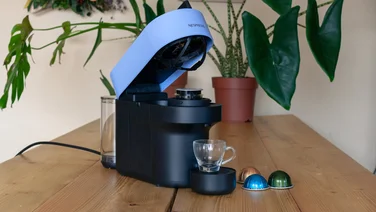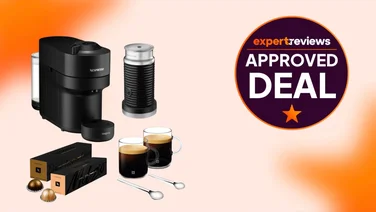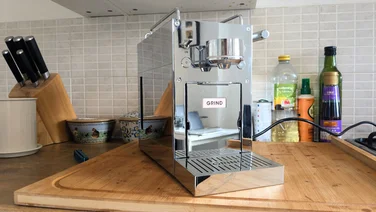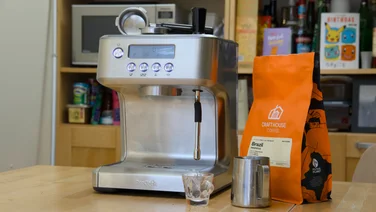To help us provide you with free impartial advice, we may earn a commission if you buy through links on our site. Learn more
















- Decent pour-over simulation
- Good adjustability
- Stylish design (if you like the colour scheme)
- Very expensive
- Grinder can be messy
While pour-over purists and drip coffee disciples might baulk at the concept of an “electric pour over system”, the Melitta EPOS promises to automate the process to achieve delicious filter coffee results without the precise effort required of manual pour-over methods. Those hoping for a review of a coffee machine that can process card payments can stop reading now.
While the EPOS has a lot of similarities with Melitta’s AromaFresh Therm Pro that I reviewed earlier this year – notably its integrated coffee grinder and brew settings – it’s quite a different machine.
Without a doubt, it’s the 360° rotating water spout that takes centre stage here, but how well does it replicate the results of manual pour-over methods? With some fine-tuning, I found it possible to achieve great-tasting results, but the EPOS is not without its annoyances, and it isn’t the easiest recommendation over some of its cheaper rivals.
What do you get for the money?
Once you get past the fact that the whole setup looks a bit like a chemistry apparatus, the Melitta EPOS is quite a good-looking piece of kit. It’s finished mostly in black with gold highlights – not a colour scheme I’m a fan of – but I do like the skeletal design of it. All that matte plastic can be a bit of a magnet for dust, though, so you’ll need to wipe it down every so often to keep it looking its best.
















On the left-hand side of the machine you have the integrated burr coffee grinder, which can be adjusted with a dial between fine, medium and coarse grind sizes. On the right-hand side is the coffee brewer assembly, comprising the machine’s 1l water tank, its boiler electronics and brew head, with the all-important shower head that’s designed to cover your coffee grounds evenly in circular motions.
Included with the machine is a filter cone (this holds Size 4 filter papers, which are widely available from Melitta and a range of other brands), a glass jug, and a packet of ten filter papers to get you started. The jug slots onto a hot plate underneath the filter, pushing open the filter cone’s drip stop as it does so.
















All this will cost you £350, which is a significant investment for a filter machine. It’s more expensive than the Aromafresh Therm Pro (£290), the Sage Luxe Brewer (£250) – another machine with a very considerate approach to filter brewing – and the Moccamaster KBG Select (£229). And it’s a touch more pricey than the exotic Fellow Aiden, too.
The integrated grinder makes up a decent chunk of this price, though, and you don’t have to buy the full package if you don’t want it. The Melitta Epour is effectively the same machine but without the grinder and costs a much more competitive £240.
















What’s it like to use?
As I’ve said, the EPOS shares a few things in common with the AromaFresh Therm Pro: Melitta’s other filter machine with an integrated coffee grinder. Aside from the grinder itself, both machines use the combination “Cup” and “Strength” settings to programme how much coffee is to be ground by the machine while the water tank empties itself completely with every brew, meaning you only fill it with as much water as you need.
While the AromaFresh Therm Pro has five Strength levels and eight Cup levels in one-cup increments, the EPOS has three Strength levels and eight Cup levels in two-cup increments. These settings are used in tandem to adjust how much coffee is ground: “Cup” sets the base amount of coffee to be ground, corresponding to the amount of cups you want, while “Strength” fine-tunes this amount depending on whether you prefer a weaker or more punchier brew.
















This was something that initially confused me when I reviewed the AromaFresh Therm Pro, but by the time I came to the EPOS I was much more familiar with these functions. Nevertheless, I carried out the same grind tests to see the results. At Cup level two and Strength level one, the grinder worked for five seconds and produced 11g of ground coffee.
















Cranking the Strength up to level three added an extra second to the grinding time and produced 14g of ground coffee. Alternatively, Cup level eight at Strength level one ground 48g of coffee in 20 seconds, and 57g in 24 seconds at Strength level three. It’s fair to say that you’ve got a decent level of adjustability with the EPOS, but I wouldn’t expect too much precision from a grinder that works on a timer: you’ll need to keep some scales to hand if you want to dial in your coffee by the gram.
Unfortunately, the EPOS’ grinder doesn’t have the automatic shutoff feature as the AromaFresh Therm Pro has and will just keep grinding nothing until the timer is up. This is a bit of a shame considering that this machine is £60 more expensive than the AromaFresh Therm Pro.
The grind fineness adjustability is satisfactory for a filter brewer such as this, but you won’t get the consistency or precision that a decent dedicated grinder might deliver. There’s not a great amount of variation from finest, medium and coarsest settings (which you’ll note from the side-by-side comparison below), but for the most part you’ve got a perfectly acceptable range for pour-over filter coffee. I wouldn’t be surprised if you’re looking at the exact same grinder on the EPOS as the AromaFresh Therm Pro, but I couldn’t say for sure.
















That’s enough said about the EPOS’ grinder. What of the machine’s selling point, the rotating dripper? This has two big benefits over manual pour-over methods: for one, it can make much greater quantities of coffee than using a V60 (and most other pour over coffee makers, for that matter). And second, it requires a damn sight less effort, concentration and time spent standing at your kitchen counter top.
According to the selected Cup setting, the machine runs different programmed “brewing profiles”, determining the rotational direction and which of the three outlet spouts it uses. Observing the dripper in action, it does a very good job of imitating the “perfect pour”, rotating slowly in both directions and achieving an even saturation of the coffee grounds, only occasionally hitting the walls of the paper.
A “Pre-brew” setting allows a short time for the coffee to “bloom” after a brief initial pour – another neat feature aimed at appeasing the speciality coffee crowds, but you can’t adjust the bloom time on this setting as you can with the Sage Luxe Brewer.
There’s also an option for “manual extraction control”, which lets you change the direction of rotation manually using the Strength buttons. As is always the case when it comes to brewing coffee it doesn’t hurt to be in control wherever possible, but I didn’t have any issues with the preset pour during my tests.
My only concern with the EPOS’ dripper is that the water didn’t always pour consistently and occasionally came out a bit “bitty”. This didn’t necessarily affect the saturation of the coffee, nor the taste of the resulting brew, but it was a bit irritating knowing I could get a smoother pour with a gooseneck kettle.
What’s the coffee like?
I found that I was able to get a decent cup of coffee from the Melitta EPOS, although it’s not always the most forgiving machine. Expect to do some experimenting and tweaking, depending on the coffee beans you’re using.
















I used two different roasts while testing the EPOS: the Guatemala La Nueva Era from Craft House as well as some cheaper Sainsbury’s Taste the Difference beans. While I did play around with the machine’s Cup/Strength settings, I used some electronic scales to weigh out the beans and water before brewing, relying on my usual ratio of 6g of coffee to 100ml of water.
While the Craft House coffee worked well with this ratio, I found it safer for the most part to err on the side of moderation. Before long, I was sticking primarily to the weakest Strength setting and the coarsest grind size for more balanced, less overpowering results – especially when using the Sainsbury’s Taste the Difference beans, which are quite a dark roast. If you’re using a very light roast, you will probably want to dial up the settings.
As I said above, the manual option for the rotating water spout is a great feature for those that want more control, though I didn’t find it made a huge difference to the flavour profile of the resulting coffee.
What could be improved?
I’d be lying if I said the benefits of an “electronic pour over system” weren’t obvious. But, as somebody who regularly makes coffee with a V60 or the Clever Dripper, I found the EPOS an awfully expensive piece of kit: £350 is a lot to pay for the convenience and greater yield.
















This wouldn’t be so bad if I hadn’t had just as good an experience with comparable machines. The £250 Sage Luxe Brewer, for instance, may not have the integrated grinder or rotating spouts, but it’s just as good at making coffee. Plus, it has a cold brew setting and you get an extra 800ml of capacity in the water tank.
You don’t need a hugely expensive grinder for a filter machine, either; I frequently use a £59 Lavazza hand grinder and, while it’s not necessarily suitable for espresso, I’ve found it produces perfectly acceptable ground coffee for pour over, filter and stovetop brewing – even if a little more physical effort is required.
If having control over your pour over is your priority, however, your best bet might be to get yourself a gooseneck kettle, a decent grinder and a V60. It’ll almost definitely cost you less overall.
















My main complaint with the EPOS, though, is that its grinder can make a lot of mess. On many occasions, I found that ground coffee would get stuck in the bottom of the grinder before coming loose after some time had passed. This meant that when I came back later to pour myself another cup or to clean up the equipment, I’d often find loose ground coffee on the base of the machine.
As well as being an annoying mess to clean up, it’s a shame to waste the coffee. Knocking on the top of the grinder can help dislodge any stuck grounds once the grinding programme has finished, but I don’t like to make a habit of slapping my coffee machines.
















A few of the machine’s quirks I’ve already mentioned: water isn’t always dispensed very consistently from the rotating water spout, and it doesn’t take long for dust to show on its black plastic exterior. Also, positioning the machine under kitchen cabinets can make the water tank (situated behind the spout) a bit awkward to reach. None of these issues are as irritating as the messy grinder, though.
Should you buy the Melitta EPOS?
Ultimately, if you don’t want to buy yourself the requisite equipment or you simply don’t want to learn how to master pour over yourself, the EPOS is a clever coffee maker that bundles that speciality coffee experience into one neat package. And, once you’ve dialled in the appropriate settings for your chosen beans, you can get a good-tasting brew. However, if you’re already a seasoned pour-over veteran, it’s harder to recommend – especially with that messy coffee grinder.
The other thing tempering my enthusiasm for the Melitta EPOS is the price. It’s the most expensive filter coffee machine that I’ve reviewed, and it doesn’t always come out on top compared to more affordable machines I’ve got my hands on. That’s not to say that the Melitta EPOS isn’t a competent filter coffee machine by any means. The automatic pour over function will appeal to many people – and deservedly so. But at £350, it’s certainly not my first choice.






